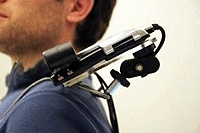Interactive surfaces could be created on papers and walls
A wearable projection system that enables users to turn pads of paper, walls or even their own hands into graphical, interactive surface has been developed.

The technology, dubbed ’Omnitouch’, was developed by researchers at Microsoft Research and Carnegie Mellon University. It relies on a depth-sensing camera similar to Microsoft Kinect to track the user’s fingers on everyday surfaces.
Omnitouch claims this allows users to control interactive applications by tapping or dragging their fingers, much as they would with touch screens found on smartphones or tablet computers.

The projector is reported to have the ability to superimpose keyboards, keypads and other controls onto any surface, automatically adjusting the surface’s shape and orientation to minimise distortion of the projected images.
‘It’s conceivable that anything you can do on today’s mobile devices, you will be able to do on your hand using Omnitouch,’ said Chris Harrison, a PhD student in Carnegie Mellon’s Human-Computer Interaction Institute.
The developers claim the palm of the hand could be used as a phone keypad, or as a tablet for jotting down brief notes. In addition, maps projected onto a wall could be panned and zoomed with the same finger motions that work with a conventional multi-touch screen.
Register now to continue reading
Thanks for visiting The Engineer. You’ve now reached your monthly limit of news stories. Register for free to unlock unlimited access to all of our news coverage, as well as premium content including opinion, in-depth features and special reports.
Benefits of registering
-
In-depth insights and coverage of key emerging trends
-
Unrestricted access to special reports throughout the year
-
Daily technology news delivered straight to your inbox










Water Sector Talent Exodus Could Cripple The Sector
Maybe if things are essential for the running of a country and we want to pay a fair price we should be running these utilities on a not for profit...